Experiences refined for people
Experiences refined for people
With billions of dollars invested in paid social advertising every year, brands have many opportunities to connect and engage with their audiences.
Explore paid social media advertising, including what it is and why it helps you reach the desired audience organic social can’t.
Social media advertising, a part of digital marketing, uses paid ads on social media platforms to reach target audiences. Marketers and advertisers can run social media ad campaigns to increase followers, engagements, clicks, and views and boost brand awareness.
Unlike traditional advertising, which takes a broad approach, social media allows for highly targeted campaigns based on demographics, interests, behaviors, and location.
Top social media advertising statistics, according to eMarketer:
Paid social media advertisements appear in several formats, including static images, videos, and carousels. They are usually labeled with tags like “sponsored,” “promotion,” or “ad” to differentiate them from organic content.
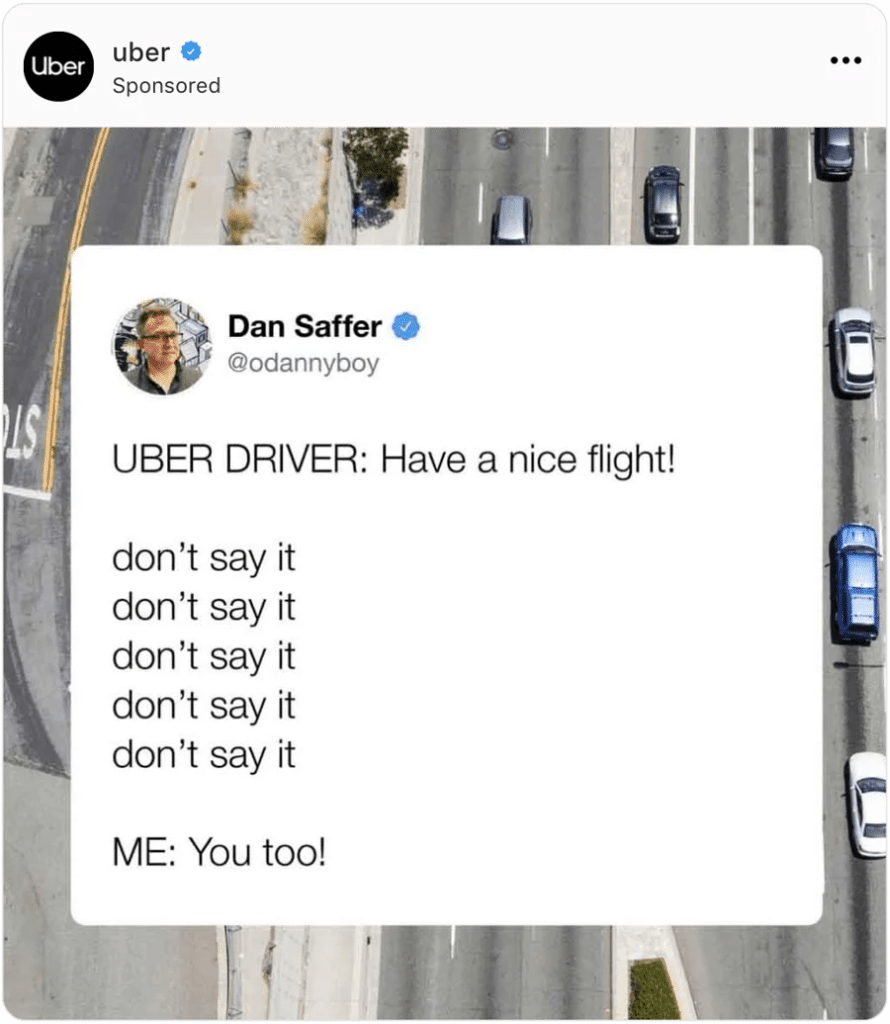
An example of an Instagram post by Uber. It includes a “sponsored” tag so audiences know it’s an ad.
Capturing consumers’ attention is increasingly challenging. Consumers are bombarded, making it difficult to stand out. Social media advertising offers a solution by targeting ideal customers at every marketing funnel stage.
For example, B2C brands can use pre-launch excitement through brand awareness campaigns, while B2B companies can re-engage audiences with remarketing efforts to drive high-ticket product sales.
Social media ads perfectly complement other forms of advertising (like Connected TV (CTV) or audio advertising). They also allow you to reach your audience across multiple devices, including smartphones and tablets, reinforcing your brand’s awareness and message.
How many social media users are there in the USA?
7 in 10 Americans will log into a social media platform today, with the average user accessing nearly 7 social media platforms every month.
Paid and organic social media marketing (SMM) involves different types of posts on social media.
Paid social refers to advertisements brands pay for to reach a targeted audience on social media platforms. This strategy helps brands reach a highly interested audience who may not have seen the brand before, driving leads and conversions.
Organic social media is any content posted on social media for free. This includes updates, photos, videos, and stories shared on a brand’s social media pages.
Unlike paid social, social media marketing posts are shown to your followers and may reach their extended network through likes, shares, and comments. Algorithms may serve your posts to non-followers based on their interactions, but there’s no guarantee of reaching them.
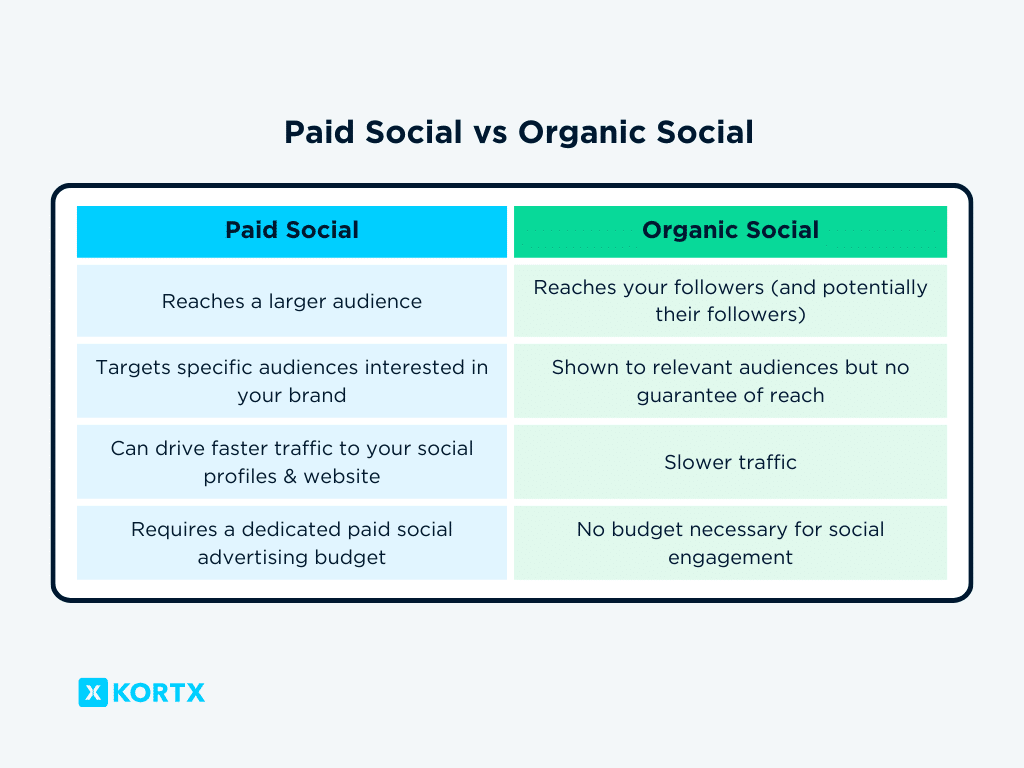
Some social media channels like Instagram allow you to boost an organic post. You can pay to show your existing content to a wider audience beyond your followers. This can help expand your reach and increase brand awareness without the need to constantly create new dedicated advertising campaigns.
However, to create an effective boosted post, you need to identify which organic content performs well.
How does paid social complement an organic social strategy?
“An effective content strategy uses both paid and organic content to build trust, break into a variety of demographics, and establish consistency in the viewers’ minds. The more they see the product, the more likely they are to make a purchase over time.
Also, some social channels like Instagram allow you to boost an existing post. This is great because you can use the organic content you are already posting. However, in order for it to be effective, you need to identify which organic content performs well. Look for posts that have already garnered high engagement, such as likes, comments, shares, and clicks. These metrics indicate that the content resonates with your audience and has the potential to perform well with a broader audience.”
Organic social media can only take you so far, with only 0.07% of a page’s fans engaging with the average organic post.
Social media ads amplify your organic efforts, extending your posts to target audiences beyond your usual reach.
Here are a few more benefits of paid social media advertising:
All social platforms have built-in metrics, and some social media schedulers, like Buffer, take it a step further by including more social information.
Meta Business Suite will show you:
Buffer and other social media scheduling tools show metrics across various platforms in one dashboard, so you can compare which platforms generate the best results and invest more time in them.
Rather than casting a wide net and hoping to attract customers, paid social ads enable you to narrow your targeting and focus on those most likely to engage with your brand.
Example: Suppose you run a fashion boutique specializing in trendy streetwear for young adults. With paid social ads, you can target individuals aged 18-30, living in urban areas, and interested in fashion, streetwear, and urban culture.
Organic reach is limited, and with tricky social media algorithms changing constantly, paid social guarantees you’ll reach the audiences you set up to target.
This also means you can reach audiences who don’t normally see your posts, increasing your odds of attracting new potential customers and helping bolster brand awareness.
Two-thirds of consumers use social media as a part of their shopping strategy, and around a third of shoppers turn to social media influencers to learn about products.
Using paid social allows you to tap into these consumer behaviors and position your brand in front of new audiences ready to purchase.
Our proven paid social strategies will guarantee you the results you’ve been looking for—more conversions, clicks, and views.
Social media advertising depends on a dynamic mix of creative content, precise targeting strategies, and real-time engagement metrics.
Here’s a breakdown of how it all comes together:
With paid social media ads, you want to target the audiences most interested and likely to convert.
Gather demographic information about your audience and use audience insights from each existing social media account.
With Facebook’s Audience Insights, you can see age and gender breakdowns, education levels, job titles, relationship statuses, and more.
How does KORTX Intelligence help identify audiences for paid social advertising campaigns?
“Our KORTX Intelligence research provides a wealth of data points about how specific audience personas spend time on social media platforms and details about demographics, shopping habits, and even device usage. More often than not, we discover that these insights lead to new social media strategies and untapped opportunities. It’s important to look beyond Meta as the default option and really dig into where brands can impact all social platforms.”
Find out which social networks your audience prefers. Tools like Keyhole.co can help you analyze which platforms to use depending on your audience. Enter a hashtag, and Keyhole will provide demographic information about how various markets use social networks.
You can also analyze your competitor’s content strategy to inform your own. Buzzsumo’s Content Analysis tab will analyze the top shared content across social networks in your industry. Look for patterns and take notes. What content formats do these audiences prefer? What social channels work best for your competitors?
Based on your research, you should be able to narrow your target audience down to a specific demographic.
A successful social media ad campaign starts with clearly defined objectives that align with your broader business goals and the specific stage of the marketing funnel you are targeting.

For brand awareness or reach, focus on increasing impressions, video views, or engagement (likes, comments, shares). These metrics show your ads are reaching a large audience and generating initial interest.
To nurture leads or drive website traffic, center objectives around click-through rates (CTR), landing page views, or lead form submissions. These metrics indicate your ads are capturing attention and prompting action.
To boost sales or conversions, prioritize metrics like cost per conversion, return on ad spend (ROAS), or purchase value. These metrics demonstrate your ad’s effectiveness in driving tangible business results.
Avoid vague goals like “increase brand awareness.” Instead, set SMART goals that are Specific, Measurable, Achievable, Relevant, and Time-bound. For example, “Increase website traffic from Facebook by 15% in the next quarter.”
📚 Related article: What is Social Commerce: Stats & Strategies for 2024
Learn what social commerce is, some examples of paid social media ads, and explore top strategies to inspire your campaigns.
3. Tailor & test platform-specific ad creatives that spark engagement through interaction & visuals.
Your ad creative is the engine of your social media campaign. It’s the visual and textual representation of your brand’s message that captures attention, sparks interest, and drives action. To resonate with your target audience, master the art of visual storytelling and the science of persuasive communication.
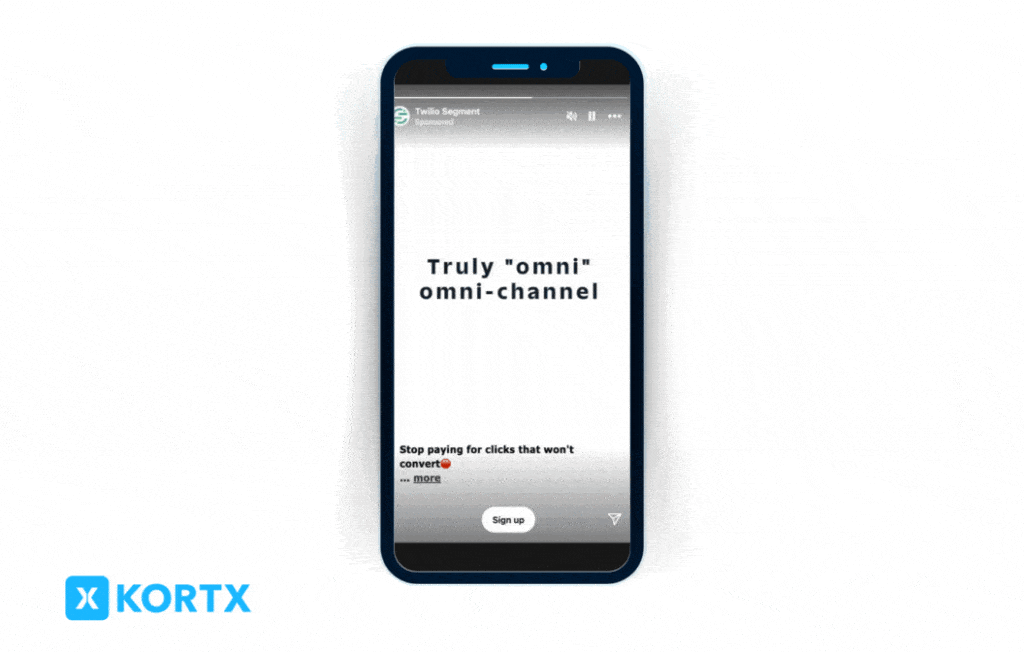
The next action in this Instagram Story social media advertisement is clearly defined in the CTA, “Sign Up.”
💡 Pro-tip: Craft at least 3 variations of your ad creative. Test different combinations of ad elements (copy, CTA components, visuals, etc) to find the most effective combinations for different audience segments.
Each social platform offers unique engagement styles and content formats. Understanding these nuances helps tailor more effective marketing strategies.
In the end, you’ll need to test different platforms, formats, and messaging to see what resonates best with your audience.
How can you ensure your social media ads resonate with both the audience and the platform’s culture?
You need to tailor your social media ads to your audience and the platform. The best social media managers spend time on these platforms, scrolling, interacting, and reading comments. This helps you understand the platform.
For instance, TikTok demands a casual, short-form approach. If you show up on the FYP in a polished suit, presenting your business as though you’re in a corporate boardroom with overly polished rhetoric, it likely won’t appeal to the TikTok audience. Or worse, you’ll get some VERY sassy comments. This platform skews younger and favors a casual, creative vibe. An overly formal presentation will be seen as insincere.”
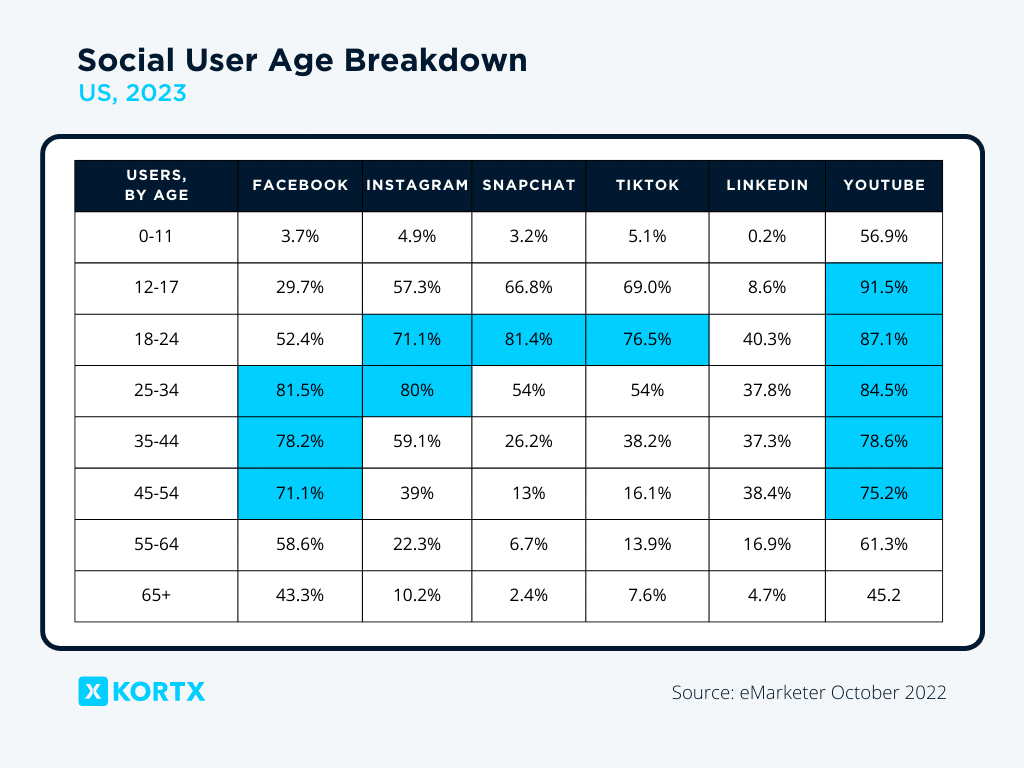
Setting the right budget and bidding strategy balances your spending with achieving your goals. Social media managers allocate 27% of their budget to organic content creation and 22% to paid advertising, highlighting the importance of a balanced approach where both efforts complement each other.
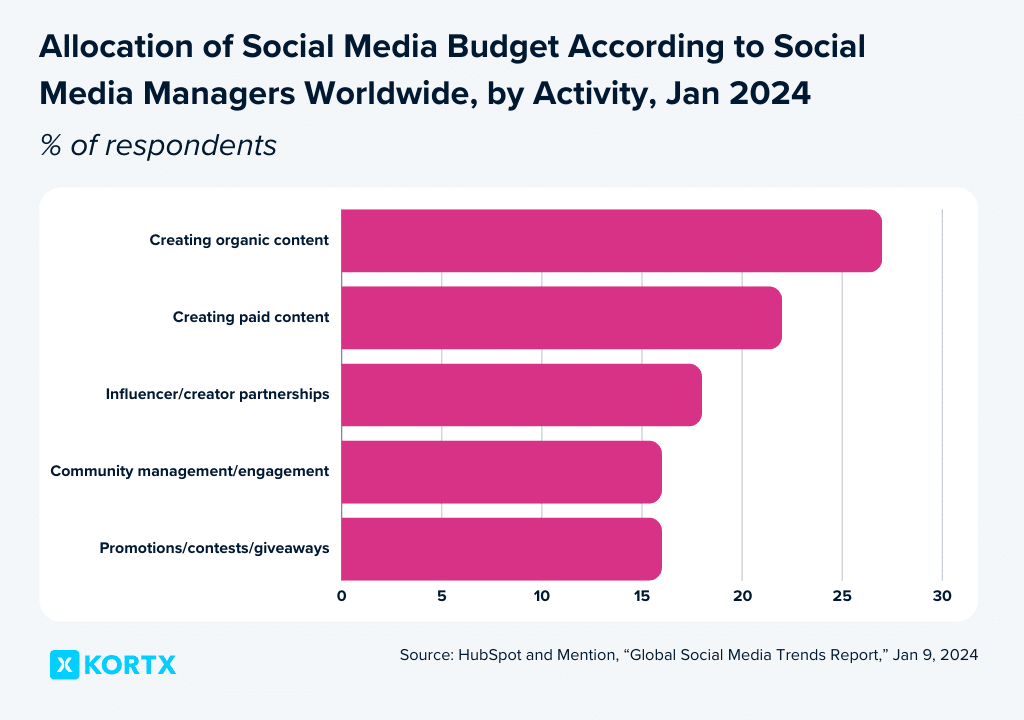
When budgeting for your social media ads, you have several options, each with its own advantages and best-use cases:
Many social platforms offer Campaign Budget Optimization (CBO), which automatically allocates your budget across different ad sets to maximize results. This automation can save time and effort, but closely monitoring ad set performance is crucial to achieving your desired outcomes.
Social media algorithms are complex, but understanding the basics can help you create ads more likely to be seen and clicked on. While each platform’s algorithm is different, they generally consider the following factors:
Social media advertising is an iterative process that requires continuous monitoring, analysis, and refinement to achieve optimal results.
Metrics provide quantitative insights into how your ads are performing. Important key performance indicators (KPIs) to monitor include the standard advertising metrics: impressions, reach, clicks, click-through rates (CTR), and more.
Most social media platforms have analytics tools, like Meta (Facebook) Ads Manager, to help you track these KPIs, but these can be limited in scope and detail.
Other tools like Buffer, Hootsuite, and SproutSocial offer more comprehensive insights, such as:
Using these tools helps you better understand your ad performance and refine your strategies for better results.
Once you’ve collected data, analyze it to uncover valuable insights. Look for patterns and trends to understand what’s working and what’s not. Consider questions like:
Based on your analysis, make data-driven adjustments to your campaigns. This could involve:
What are the best platforms for social media advertising?
“The best platform yields the best results for your business, increasing the odds of engagement, conversions, and sales. Then, you can launch a paid social strategy that targets the right people at the right time.
When determining the best platform for your social media advertising, consider your campaign goals and your target audience. If you want to target homebuyers (typically between the ages of 35 and 44), advertising on Facebook, Instagram, and YouTube makes sense.
Or, if you’re promoting beauty products for older women, your campaign goal might be to increase brand awareness and engagement, which is most likely to happen on Facebook and Instagram.”
Each social platform offers unique features and targeting options to enhance your campaigns and deliver measurable results.
Explore the most effective platforms for running paid social media ad campaigns as well as examples of paid social media advertising.
Using its Meta (Facebook) Ads Manager platform, Facebook provides comprehensive advertising options across awareness, consideration, and conversion stages of the buyer’s journey.
You can set a choice of six campaign objectives for your campaign, including:
The most common ad types Facebook supports include:
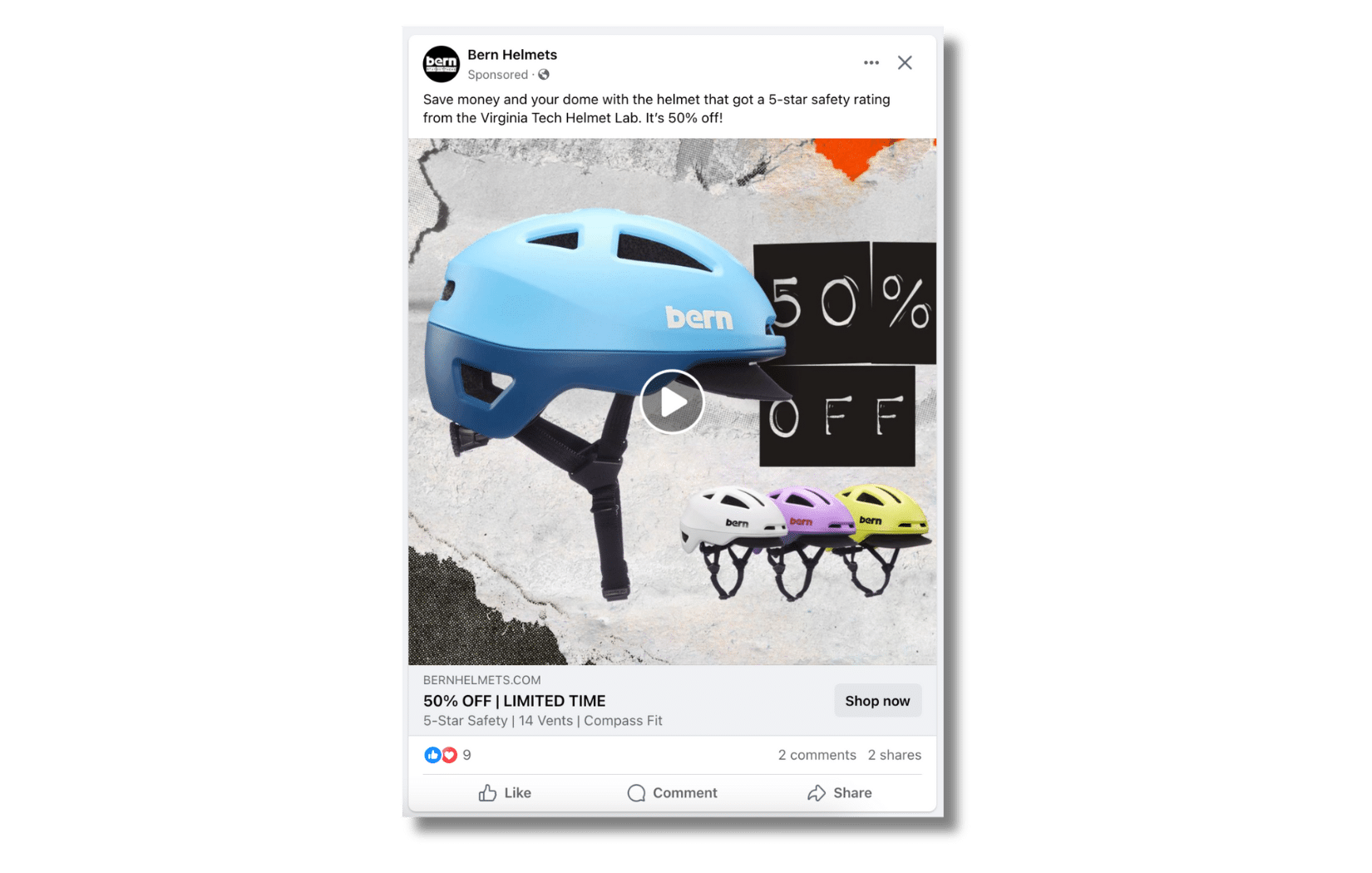
Facebook also supports more engaging ad types, including:
Facebook also offers dynamic ads that capture intent signals from customer interactions to show the right products to the right people. These ads automatically promote your product catalog across Facebook, Instagram, and Audience Network without creating individual ads.
Selecting the ideal ad format affects your social media ads’ presentation and content capacity. Different formats offer various layouts and advantages based on your campaign objectives.
The ad objective you select influences the available formats. For example, a sales goal might use the “Collection” format to showcase multiple items, while a brand awareness goal might use a single image or video format.
Facebook advertising costs vary depending on multiple factors such as industry, targeting, and campaign objectives. On average, advertisers can expect to pay anywhere from $0.30 to $2.00 per click, with costs potentially increasing for highly competitive industries or during peak advertising seasons.
What ad objective should I choose for Facebook?
Facebook recommends optimizing for Conversions, Purchase, Add-To-Cart or Registration to maximize your broad audience targeting. We also recommend an attribution window of 7 days for optimized bidding.
Instagram is great for visually appealing, immersive advertising campaigns. With its robust shopping functionalities—buy buttons, Instagram checkout, product tags, and shoppable posts—It is also a top platform for social retailing.
Instagram offers ads like Facebook, managed through Meta (Facebook) Ad Manager.
You can target Instagram users based on location, demographics, interests, and behavior and create custom and lookalike audiences to find new users similar to your ideal buyer.
Target users across their buyer journey with these Instagram ad objectives:
Instagram allows you to run ads in the news feed and the Explore tab. Here are the eight ad formats currently available on Instagram:

The cost per click (CPC) for Instagram is around $1.20, covering all clicks on an ad, including link clicks and interactions like likes, comments, and shares.
The Instagram CPC varies between $0.50 and $0.95 for ads with a destination URL.
✨ Shoppable Instagram Reels offer a new way to get discovered. ✨
As short-form videos take off, Instagram Reels offer a way to showcase your products. Instagram Reels are now shoppable, which means businesses can tag the product with a purchase link.
X, formerly Twitter, provides feature-rich options for audience segmentation by keywords, interests, and more.
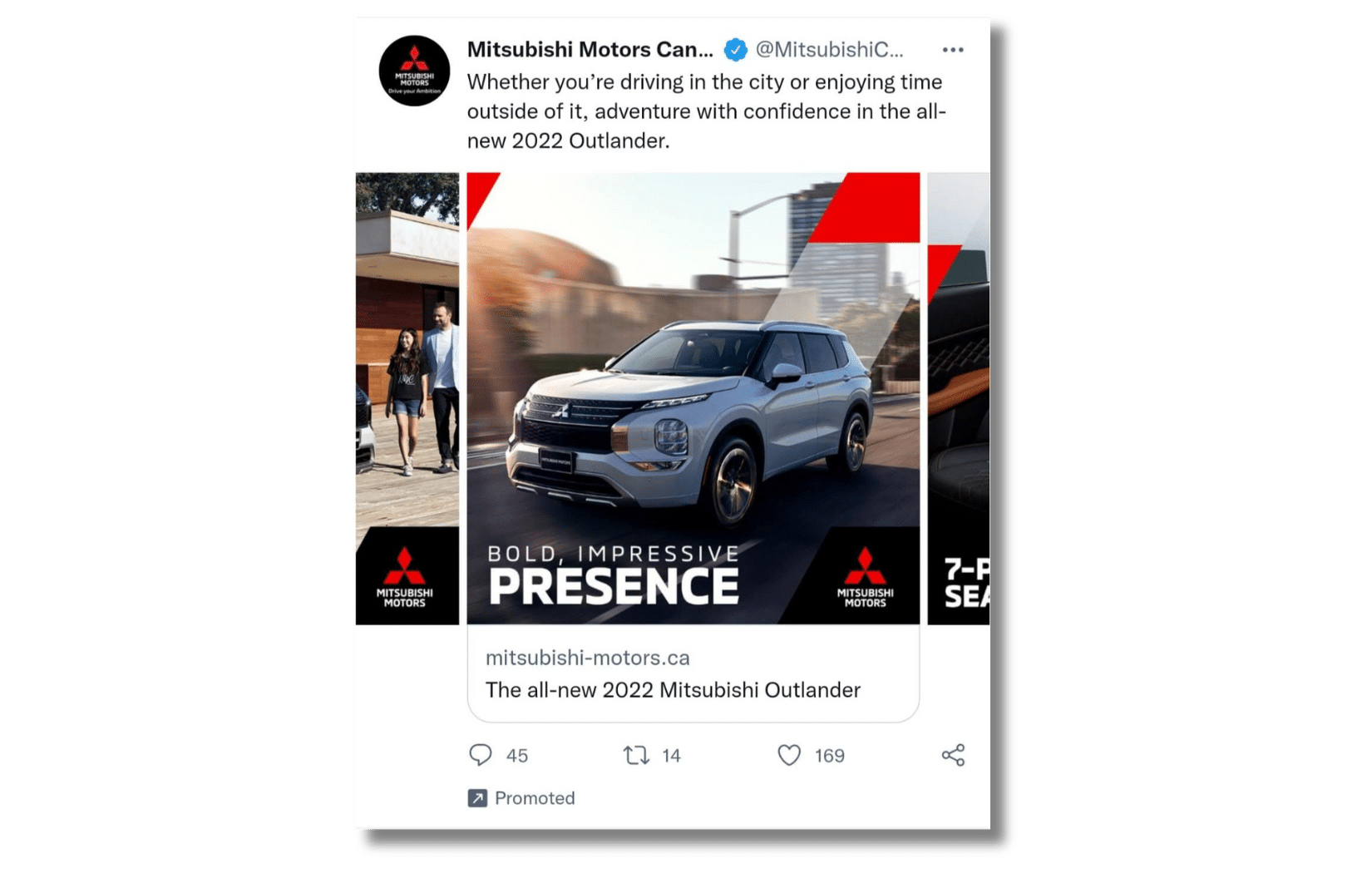
The average X (Twitter) ad costs between $0.26 and $0.50, and the average cost per follow ranges from $1.01 to $2.00.
Let KORTX take a look. We can help your social media advertising into a lead-generating, sales-boosting machine.
LinkedIn provides access to a professional user base of over 950 million, ideal for B2B marketing and targeting specific industries or job titles.
LinkedIn’s targeting options differ from Facebook and Twitter. They focus primarily on professional criteria such as education, organization size, sector, and job title.
LinkedIn offers various ad formats to help achieve specific objectives. Here are the main types:
1. Sponsored Content: Sponsored Content reaches a highly engaged audience in the LinkedIn news feed.
2. Sponsored Messaging: Sponsored Messaging engages your audience in LinkedIn Messaging, where professional conversations happen.
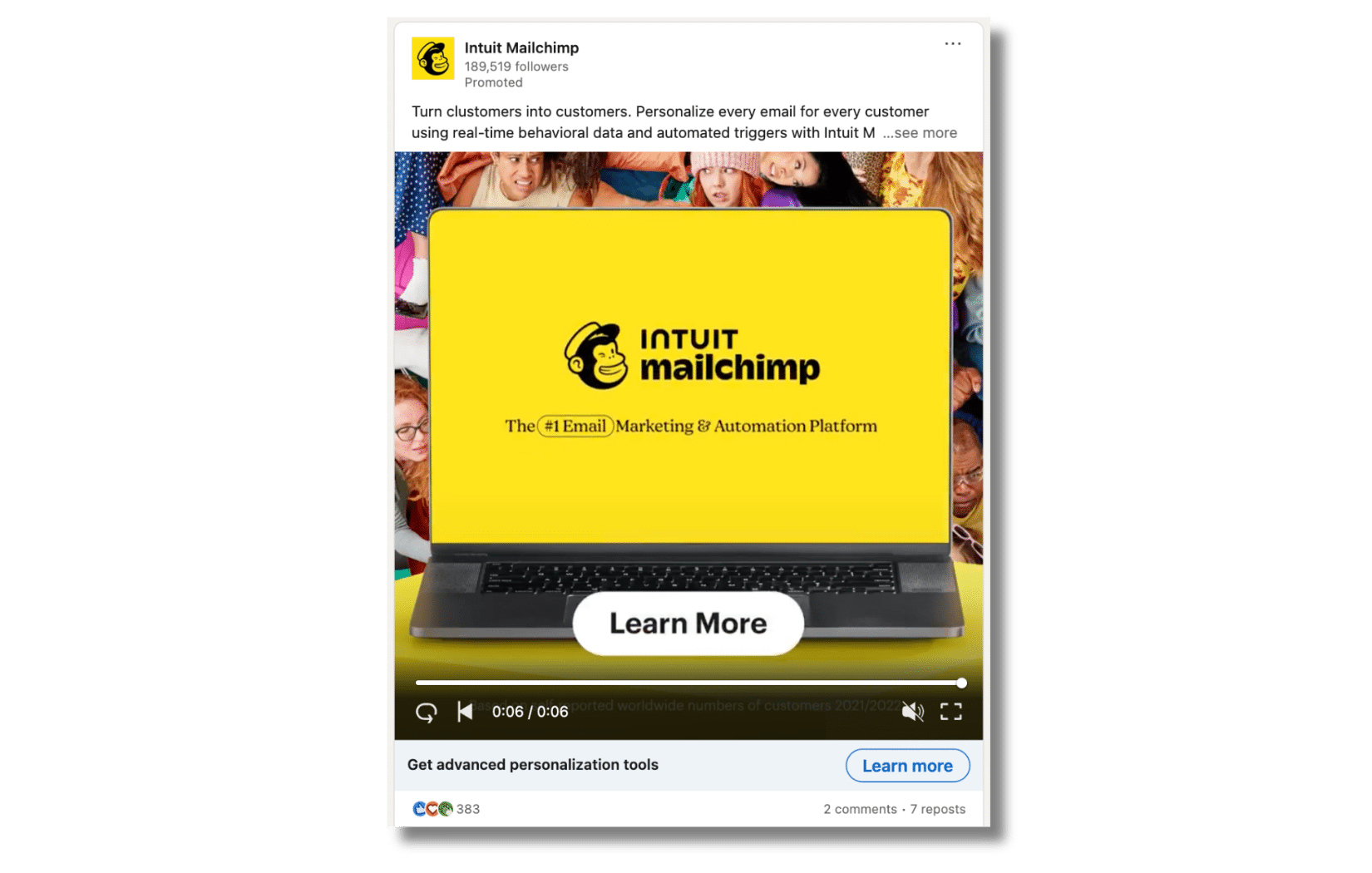
3. Text and Dynamic Ads: Text and Dynamic Ads are cost-effective ads in the LinkedIn right rail.
On average, LinkedIn advertising costs:
LinkedIn requires a $10.00 minimum daily spend. They suggest advertisers spend $25 for new advertisers and $50-100 for existing advertisers using USD, and the equivalent of $25 for new campaigns in other currencies.
TikTok’s algorithm and user behavior foster viral content, offering brands explosive reach. The platform’s focus on short-form, user-generated content encourages creativity and authenticity, ideal for playful, engaging brands.
Like Instagram, TikTok has a thriving influencer community that amplifies your brand’s message to targeted demographics. TikTok is also enhancing its business model with advanced ad formats and CRM integrations, giving advertisers greater control over their campaigns.

Click to see the full TikTok-sponsored post.
As of 2024, TikTok’s average CPM rate starts at $10 per 1,000 views, and the average CPC is approximately $1. The minimum campaign budget requirement is $500. Additionally, TikTok imposes daily budget requirements of at least $50 per day at the campaign level and $20 per day at the ad group level.
YouTube, the second-largest search engine and third-most visited website, is ideal for general advertising. Quality content on YouTube can also boost your organic SEO traffic by adding backlinks in your profile description.
Bellroy, a sustainable accessories retailer, grew sales with shoppable YouTube videos.
On average, YouTube advertising costs $0.11 – $0.50 per view, with businesses typically setting a daily budget of $10. YouTube doesn’t require a minimum spend for your ad campaign, so how much you spend depends on the daily budget you set for your campaign.
Snapchat favors casual, fun, and visually engaging content, making it an ideal space for brands to authentically showcase their personality and connect with younger demographics.
Snapchat’s advertising platform offers a range of objectives tailored to various marketing objectives across the funnel:
The average “Cost Per Mille” (CPM) on Snapchat is around $3.03. Snapchat advertising offers flexibility for businesses of all sizes, with a minimum daily budget of just $5.
You have the option to set either a daily budget to control your spending each day or a lifetime budget for the entire campaign duration.
Here’s how to optimize your social media ad campaigns:
Diving headfirst into social media advertising with a large budget can be risky, especially if you’re new to the platform.
A cautious and measured approach is key to success.
Taking a “start small and scale” approach reduces risk, giving you room to learn each platform, refine your ads, and grow your social ad spend strategically.
When you’re getting started, look at what ads are running best. Researching competing ads, preferably direct competitors, can inspire your own paid social campaigns.
You can find past Facebook and Instagram advertisements through the Facebook Ad Library.

TikTok also has a Creative Center or Top Ads, so you can see the most successful ads on the platform, though you can’t search for specific businesses.
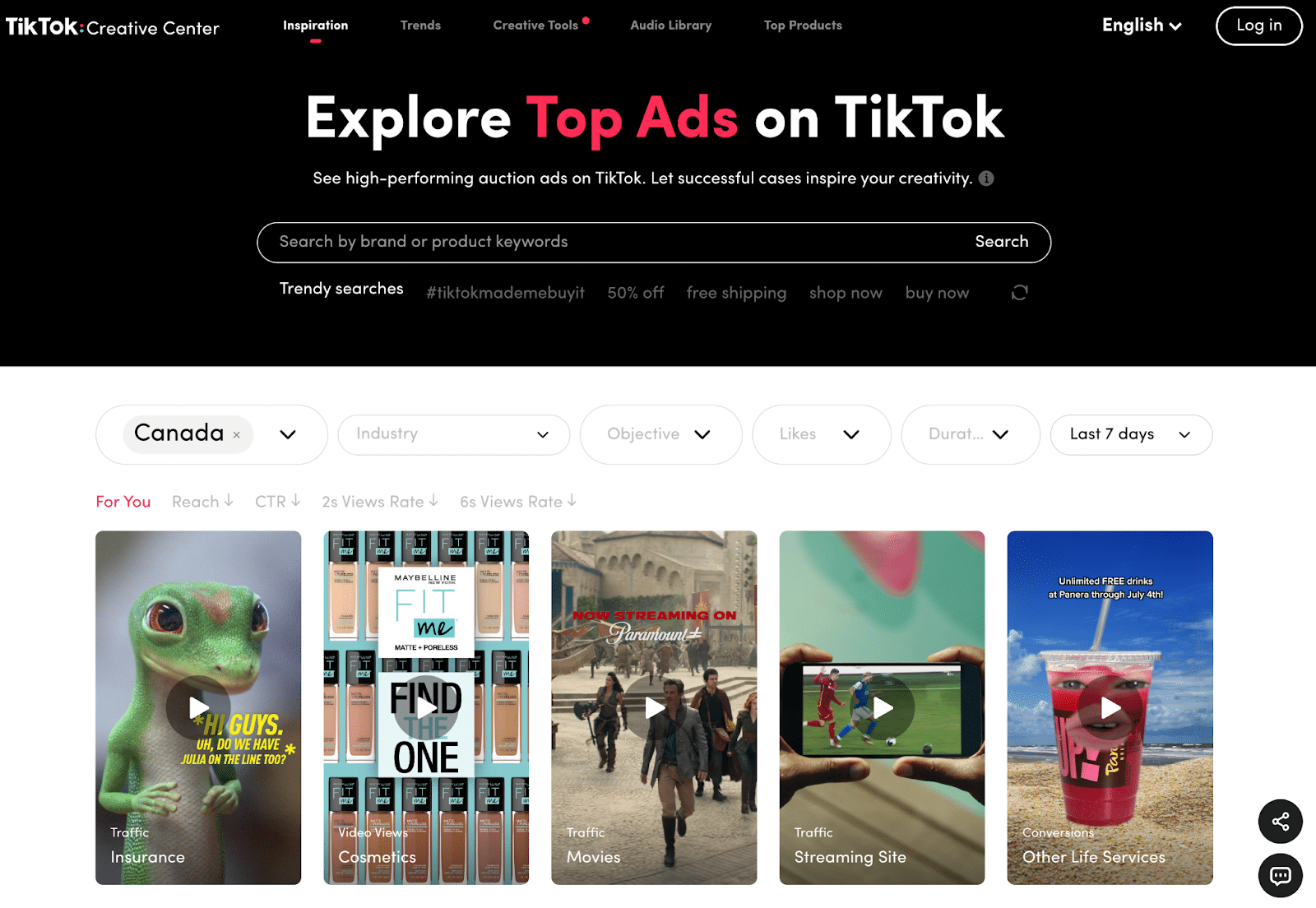
While it’s important to track your ad’s performance—checking that pixels are firing and the budget isn’t draining too fast—avoid making hasty adjustments based on short-term results.
Don’t be afraid to break the mold and experiment with your paid social campaigns. Running campaigns takes time and offers a valuable learning experience to determine what strategies and approaches work best for your brand.
Let a campaign run for at least a month without making any major adjustments in the initial week (or even the first few days).
Even if things initially appear discouraging, resist the urge to intervene too soon and allow your campaign to gather valuable data and insights.
Platforms like Facebook offer Dynamic Creative Optimization (DCO), which allows for testing multiple variations of copy, headlines, and visuals to optimize performance and automate the selection of the most effective combinations.
When you’re unsure which media or ad parts resonate with your audiences, dynamic creative will mix and match them in new ways to improve your ad performance.
Example: A clothing retailer can use dynamic ad creative with Facebook. Facebook will take the different combinations of product images, headlines, and CTAs and test them against the audience you set. Then, it will automatically select and display the winning variations for different audience segments, resulting in better goal outcomes.
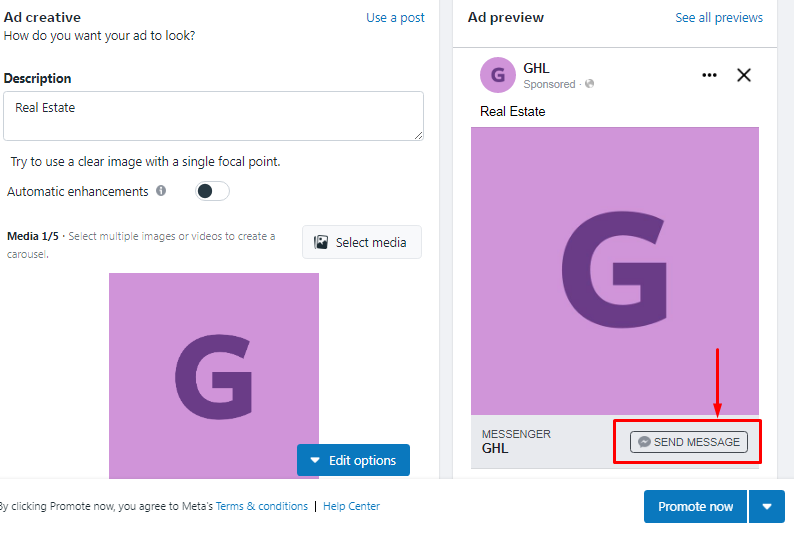
An example of selecting multiple creative images for a campaign.
Ad platforms were built to help you optimize your ads, so let the ads platform do its thing while your campaign runs.
How often should you update or change out your ads?
“A general rule of thumb is to switch out creatives every 4-6 weeks based on their performance, avoiding unnecessary changes to highly successful ones while addressing underperforming ones earlier.”
📚 Related article: What Is Dynamic Creative Optimization (DCO) & Why It Matters?
Learn how Dynamic Creative Optimization (DCO) can make your advertisements timely, efficient, and incredibly personalized.
Throwing together an image and some quick copy isn’t enough for social platforms.
You need a focused strategy to get results.
📏 What metrics do you use to measure a paid social campaign?
Paid social advertising offers various ad objectives that cater to different campaign goals. Whether you aim to increase video views, drive traffic, or generate conversions, you can select the appropriate ad objective, such as cost per video view, cost per landing page view, or cost per conversion.
Paid social media is the future of targeted marketing. To get the most out of it, you need to master the nuances of each platform and apply the right strategies.
As social platforms evolve, adding paid ads to your approach isn’t optional—it’s how you reach untapped audiences and drive real results. Get it right, and you’ll connect with people you wouldn’t otherwise reach.
Lean on KORTX’s expertise to generate new business through your paid social strategy.
Josh Pheneger is an Account Strategist at KORTX. He likes to play golf, explore the city, and spend time in coffee shops.
From us to your inbox weekly.